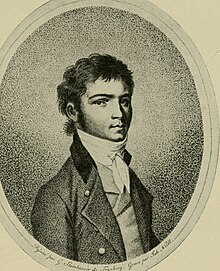Piano Sonata No. 7 (Beethoven)
This article relies largely or entirely on a single source. (June 2016) |

Ludwig van Beethoven's Piano Sonata No. 7 in D major, Op. 10, No. 3, was dedicated to the Countess Anne Margarete von Browne, and written in 1798. This makes it contemporary with his three Op. 9 string trios, his three Op. 12 violin sonatas, and the violin and orchestra romance that became his Op. 50 when later published. The year also saw the premiere of a revised version of his second piano concerto, whose original form had been written and heard in 1795.[1]
Structure
[edit]It is divided into four movements:
Analysis
[edit]The Op. 10 sonatas are usually described as angular or experimental, as Beethoven began moving further and further away from his earlier models. This third sonata of the set is the longest at approximately 24 minutes. It is the only one of the Op. 10 sonatas that has four movements. The second movement is famous for its intimations of later tragic slow movements, as well as for its own beauty.
I. Presto
[edit]
The first movement is in sonata form.[2]
II. Largo e mesto
[edit]
The second movement is in ternary form.[2]
III. Menuetto: Allegro
[edit]
The third movement is in ternary form.[2]
IV. Rondo
[edit]
The fourth movement is in rondo form.[2]
References
[edit]External links
[edit]- A lecture by András Schiff on Beethoven's piano sonata Op. 10, No. 3
- For a public domain recording of this sonata, visit Musopen
- Hewitt, Angela (2006). Liner Notes to Beethoven: Piano Sonatas Opp 10/3, 7 & 57 (PDF) (CD). Hyperion Records. CDA67518.
- Piano Sonata No. 7: Scores at the International Music Score Library Project
- Recording by Paavali Jumppanen, piano from the Isabella Stewart Gardner Museum

